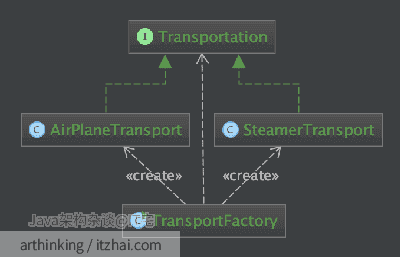1、简单工厂方法模式

如上图,运输工具包含了飞机和轮船,统一由运输工厂创建。
运输工具接口:
1
2
3
| public interface Transportation {
void transport();
}
|
飞机:
1
2
3
4
5
6
7
| public class AirPlaneTransport implements Transportation{
@Override
public void transport() {
System.out.println("Transport by airplane...");
}
}
|
轮船:
1
2
3
4
5
6
7
| public class SteamerTransport implements Transportation {
@Override
public void transport() {
System.out.println("transport by steamer...");
}
}
|
运输工具工厂:
1
2
3
4
5
6
7
8
9
10
11
12
13
14
15
16
17
18
19
20
21
| public class TransportFactory {
public static Transportation createTransport(int type) {
Transportation result = null;
switch (type) {
case TransportConstants.TYPE_AIRPLANE:
result = new AirPlaneTransport();
break;
case TransportConstants.TYPE_STEAMER:
result = new SteamerTransport();
break;
}
return result;
}
public static void main(String[] args) {
Transportation transportation = TransportFactory.createTransport(TransportConstants.TYPE_AIRPLANE);
transportation.transport();
}
}
|
1.1、优点
- 达到了对象创建和使用分离的目的;
- 客户端通过传入特定类型参数直接通过工厂类创建产品,无需知道具体类名;
- 如果需要新增具体产品,无需修改客户端调用代码,提供系统灵活性。
1.2、缺点
- 工厂中需要根据特性类型来创建产品,职责过重;
- 添加新的具体产品,需要修改工厂方法,违反了开闭原则;
- 简单工厂是静态方法,无法继承扩展,不能形成基于工厂的继承体系。
2、工厂方法模式
3、抽象工厂模式
References
工厂方法模式
【设计模式】简单工厂、工厂方法与抽象工厂的区别



